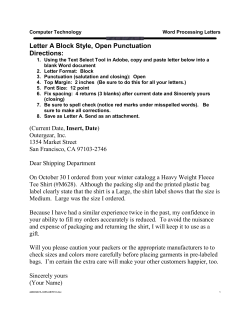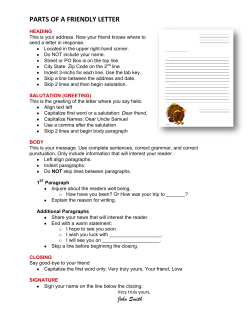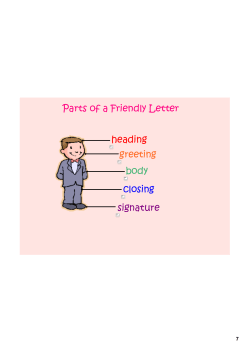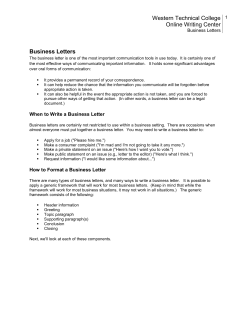
Writing the Basic Business Letter Parts of a Business Letter
Writing the Basic Business Letter Parts of a Business Letter This resource is organized in the order in which you should write a business letter, starting with the sender's address if the letter is not written on letterhead. Sender's Address The sender's address usually is included in letterhead. If you are not using letterhead, include the sender's address at the top of the letter one line above the date. Do not write the sender's name or title, as it is included in the letter's closing. Include only the street address, city, and zip code. Date The date line is used to indicate the date the letter was written. However, if your letter is completed over a number of days, use the date it was finished in the date line. When writing to companies within the United States, use the American date format. (The United States-based convention for formatting a date places the month before the day. For example: June 11, 2001. ) Write out the month, day and year two inches from the top of the page. Depending which format you are using for your letter, either left justify the date or tab to the center point and type the date. Inside Address The inside address is the recipient's address. It is always best to write to a specific individual at the firm to which you are writing. If you do not have the person's name, do some research by calling the company or speaking with employees from the company. Include a personal title such as Ms., Mrs., Mr., or Dr. Follow a woman's preference in being addressed as Miss, Mrs., or Ms. If you are unsure of a woman's preference in being addressed, use Ms. If there is a possibility that the person to whom you are writing is a Dr. or has some other title, use that title. Usually, people will not mind being addressed by a higher title than they actually possess. To write the address, use the U.S. Post Office Format. For international addresses, type the name of the country in all-capital letters on the last line. The inside address begins one line below the sender's address or one inch below the date. It should be left justified, no matter which format you are using. Salutation Use the same name as the inside address, including the personal title. If you know the person and typically address them by their first name, it is acceptable to use only the first name in the salutation (for example: Dear Lucy:). In all other cases, however, use the personal title and last/family name followed by a colon. Leave one line blank after the salutation. If you don't know a reader's gender, use a nonsexist salutation, such as their job title followed by the receiver's name. It is also acceptable to use the full name in a salutation if you cannot determine gender. For example, you might write Dear Chris Harmon: if you were unsure of Chris's gender. Body For block and modified block formats, single space and left justify each paragraph within the body of the letter. Leave a blank line between each paragraph. When writing a business letter, be careful to remember that conciseness is very important. In the first paragraph, consider a friendly opening and then a statement of the main point. The next paragraph should begin justifying the importance of the main point. In the next few paragraphs, continue justification with background information and supporting details. The closing paragraph should restate the purpose of the letter and, in some cases, request some type of action. Closing The closing begins at the same vertical point as your date and one line after the last body paragraph. Capitalize the first word only (for example: Thank you) and leave four lines between the closing and the sender's name for a signature. If a colon follows the salutation, a comma should follow the closing; otherwise, there is no punctuation after the closing. Enclosures If you have enclosed any documents along with the letter, such as a resume, you indicate this simply by typing Enclosures one line below the closing. As an option, you may list the name of each document you are including in the envelope. For instance, if you have included many documents and need to ensure that the recipient is aware of each document, it may be a good idea to list the names. Typist initials Typist initials are used to indicate the person who typed the letter. If you typed the letter yourself, omit the typist initials. A Note About Format and Font Block Format When writing business letters, you must pay special attention to the format and font used. The most common layout of a business letter is known as block format. Using this format, the entire letter is left justified and single spaced except for a double space between paragraphs. Modified Block Another widely utilized format is known as modified block format. In this type, the body of the letter and the sender's and recipient's addresses are left justified and single-spaced. However, for the date and closing, tab to the center point and begin to type. Semi-Block The final, and least used, style is semi-block. It is much like the modified block style except that each paragraph is indented instead of left justified. Keep in mind that different organizations have different format requirements for their professional communication. While the examples provided by the OWL contain common elements for the basic business letter (genre expectations), the format of your business letter may need to be flexible to reflect variables like letterheads and templates. Our examples are merely guides. Font Another important factor in the readability of a letter is the font. The generally accepted font is Times New Roman, size 12, although other fonts such as Arial may be used. When choosing a font, always consider your audience. If you are writing to a conservative company, you may want to use Times New Roman. However, if you are writing to a more liberal company, you have a little more freedom when choosing fonts. Punctuation Punctuation after the salutation and closing - use a colon (:) after the salutation (never a comma) and a comma (,) after the closing. In some circumstances, you may also use a less common format, known as open punctuation. For this style, punctuation is excluded after the salutation and the closing. Copyright ©1995-2013 by The Writing Lab & The OWL at Purdue and Purdue University. All rights reserved. This material may not be published, reproduced, broadcast, rewritten, or redistributed without permission. Use of this site constitutes acceptance of our terms and conditions of fair use.
© Copyright 2025





















